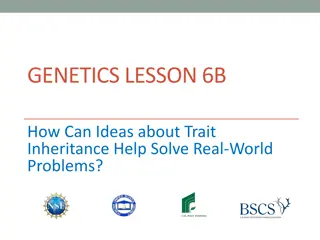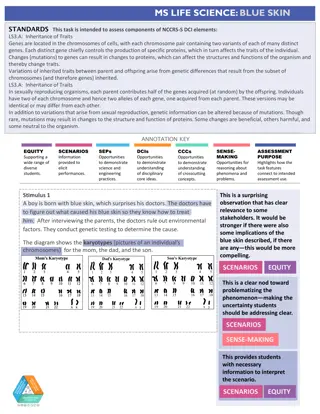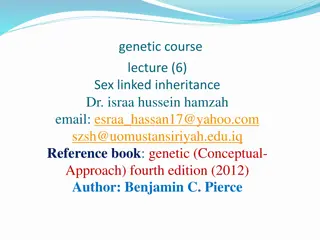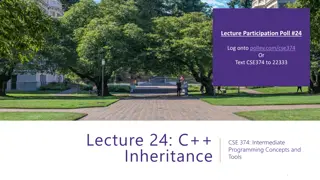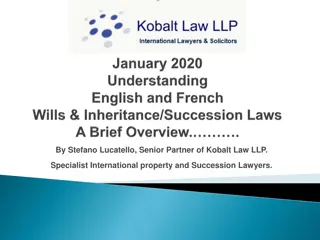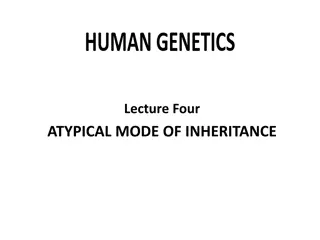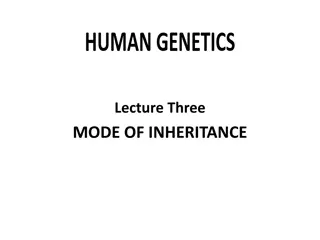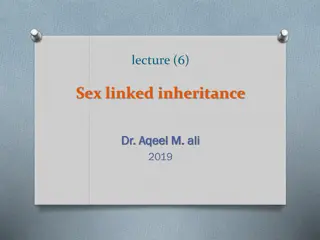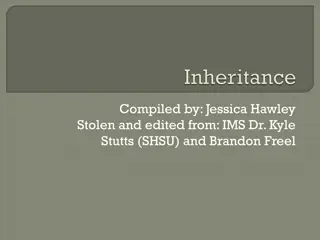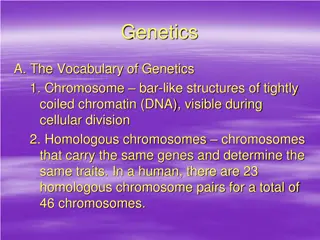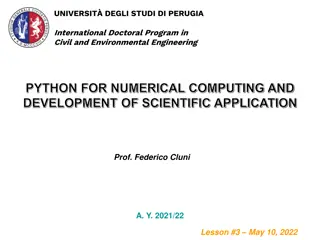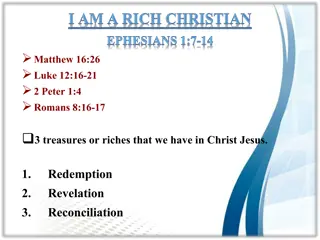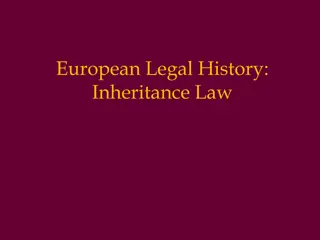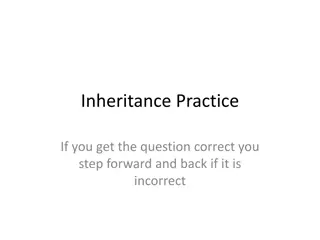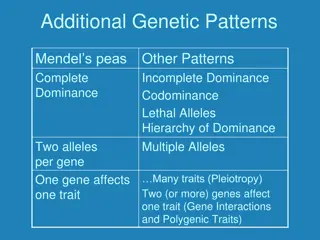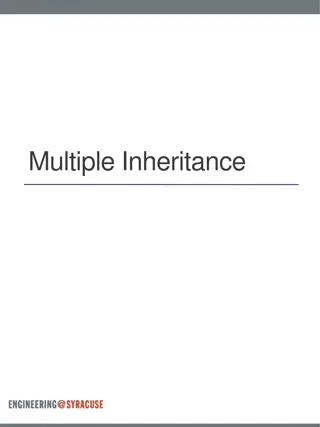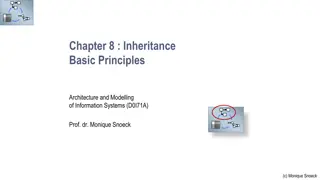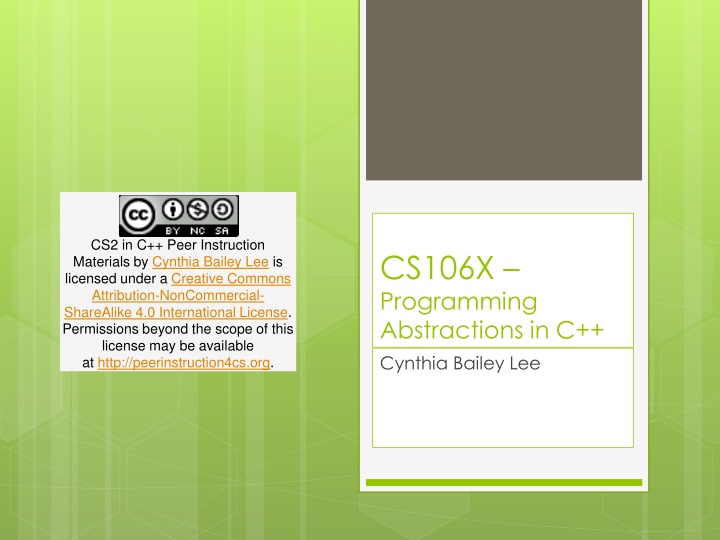
Inheritance and Polymorphism in C++ Through Practical Examples
Explore the concepts of inheritance and polymorphism in C++ with practical examples and peer instruction materials by Cynthia Bailey Lee. Delve into basic inheritance, expression trees, and the virtual keyword to enhance your C++ programming skills. Discover how to work with classes like Circle and FilledCircle, and test your knowledge with code snippets and exercises.
Download Presentation

Please find below an Image/Link to download the presentation.
The content on the website is provided AS IS for your information and personal use only. It may not be sold, licensed, or shared on other websites without obtaining consent from the author. If you encounter any issues during the download, it is possible that the publisher has removed the file from their server.
You are allowed to download the files provided on this website for personal or commercial use, subject to the condition that they are used lawfully. All files are the property of their respective owners.
The content on the website is provided AS IS for your information and personal use only. It may not be sold, licensed, or shared on other websites without obtaining consent from the author.
E N D
Presentation Transcript
Creative Commons License CS2 in C++ Peer Instruction Materials by Cynthia Bailey Lee is licensed under a Creative Commons Attribution-NonCommercial- ShareAlike 4.0 International License. Permissions beyond the scope of this license may be available at http://peerinstruction4cs.org. CS106X Programming Abstractions in C++ Cynthia Bailey Lee
2 Today s Topics Basic inheritance in C++ Some help with Stanford 1-2-3 Expression trees Inheritance and the virtual keyword Polymorphism
Inheritance in C++ The basics
class Circle { public: double myArea() { return 3.14159 * radius * radius; } void setLoc(Loc center) { centerx = center.x; centery = center.y; } Loc getLoc() { return Loc(centerx, centery); } private: double halfMoonArea() { return myArea / 2; } int radius, centerx, centery; }; class FilledCircle : public Circle { public: void setColor(std::string color) { this->color = color; } std::string getColor() { return color; } private: std::string color; }; If we add a new public method void doStuff() to FilledCircle, which of the following lines of code would not be legal to include in doStuff()? int topedge = centery radius; size_t colorstrlen = color.length(); double quarterarea = this->halfMoonArea()/4 + this->myArea()/8; Other/none/more than one A. B. C. D.
Stanford 1-2-3 Walkthrough The Expression class
Walkthrough of Stanford 1-2-3 Excel-like spreadsheet Among other things, it needs to parse expressions We did something similar to this earlier in the quarter (see next slide)
We can play the same game with non-alpha characters as keys: What does this print? void traverse(Node *node) { if (node != NULL) { traverse(node->left); traverse(node->right); cout << node->key << " "; } } * + / * + / 3 4 8 2 * + 3 4 / 2 3 + 4 * 8 / 2 3 4 + 8 2 / * Other/none/more A. B. C. D. E. 3 4 8 2
Evaluation of CompoundExp This is in the implementation of CompoundExp let s take a look at the .h file to see what op, lhs, and rhs are
Expression (base class) Note: you cannot actually create an Expression object These methods are never implemented (note the = 0 ) Expression exists solely to provide a base class to others pure virtual
Another Derived class: DoubleExp
Another Derived class: IdentifierExp
Inheritance and the is a relationship To write class B is derived from class A : class B : public class A { } This means that: An object of type B is a A Any public methods of class A are inherited by class B, and become public methods of class B Any private methods and data of class A are not accessible by class B B may add some of its own public/private methods and data in the {} braces
class Square : public ________________ { public: virtual double myArea() { return side*side; } private: int length; }; class Rectangle : public ________________ { public: virtual double myArea() { return length*width; } private: int length, width; }; class Shape { public: virtual double myArea() = 0; }; How should we fill in the blanks so that the class relationships match our understanding of geometry? (note: ignore ordering of declarations) Square, Rectangle Shape, Shape Rectangle, Shape Other/none/more than one A. B. C. D.
Stanford 1-2-3 eval CompoundExp, DoubleExp, and IdentifierExp can all be lhs/rhs of CompoundExp, which is type Expression* Because of the is a relationship This diagram shows a CompoundExp object as the root of a tree, and the children are the LHS and RHS (private member variables of type Expressio*). LHS points to an object of type DoubleExp, with value 3.7. RHS points to an object of type IdentifierExp with name foo . Note that it is ok for the RHS and LHS pointers to point to DoubleExp and IdentifierExp objects, because these are derived classes of the base class Expression.
Stanford 1-2-3 eval This diagram shows a CompoundExp object as the root of a tree, and the children are the LHS and RHS (private member variables of type Expressio*). LHS points to an object of type DoubleExp, with value 3.7. RHS points to an object of type IdentifierExp with name foo . Note that it is ok for the RHS and LHS pointers to point to DoubleExp and IdentifierExp objects, because these are derived classes of the base class Expression. CompoundExp doesn t want to care exactly what type its lhs and rhs are Just calls eval() on whatever they are and gets the right value
class Mammal { public: virtual void makeSound() = 0; string toString() { return Mammal ; } }; class Cat : public Mammal { public: string toString() { return Cat ; } }; class Siamese : public Cat { public: virtual void makeSound() { cout << meow << endl; } }; How many of these compile? (A) 0-1 (B) 2-3 (C) 4 (D) I don t know! Siamese * s = new Siamese; Mammal * m = new Cat; Cat * c = new Siamese; Siamese * s = new Cat;
Rules for virtual: pure virtual If a method of a class looks like this: virtual returntype method() = 0; then this method is a called pure virtual function and the class is called an abstract class Abstract classes are like Java interfaces You cannot do = new Foo(); if Foo is abstract (just like Java interfaces) ALSO, you cannot do = new DerivedFoo(); if DerivedFoo extends Foo and DerivedFoo does not implement all the pure virtual methods of Foo
Rules for virtual: runtime calls BaseType * obj = new DerivedType(); If we call a method like this: obj.method(), two different things could happen: If method is not virtual, then BaseType s implementation of method is called If method is virtual, then DerivedType s implementation of method is called DerivedType * obj = new DerivedType(); If we call a method like this: obj.method(), only one thing could happen: DerivedType s implementation of method is called 1. 2. 1.
class Mammal { public: virtual void makeSound() = 0; string toString() { return Mammal ; } }; class Cat : public Mammal { public: virtual void makeSound() { cout << rawr << endl; } string toString() { return Cat ; } }; class Siamese : public Cat { public: virtual void makeSound() { cout << meow << endl; } string toString() { return Siamese ; } }; (A) Mammal (B) Cat (C) Siamese (D)Gives an error (E)Other/none/more What is printed? Siamese * s = new Siamese; cout << s->toString();
class Mammal { public: virtual void makeSound() = 0; string toString() { return Mammal ; } }; class Cat : public Mammal { public: virtual void makeSound() { cout << rawr << endl; } string toString() { return Cat ; } }; class Siamese : public Cat { public: virtual void makeSound() { cout << meow << endl; } string toString() { return Siamese ; } }; (A) Mammal (B) Cat (C) Siamese (D)Gives an error (E)Other/none/more What is printed? Cat * c = new Siamese; cout << c->toString();
class Mammal { public: virtual void makeSound() = 0; string toString() { return Mammal ; } }; class Cat : public Mammal { public: virtual void makeSound() { cout << rawr << endl; } string toString() { return Cat ; } }; class Siamese : public Cat { public: virtual void makeSound() { cout << meow << endl; } string toString() { return Siamese ; } }; (A) rawr (B) meow (C) Siamese (D)Gives an error (E)Other/none/more What is printed? Cat * c = new Siamese; c->makeSound();
How does this relate to Stanford 1-2-3? This diagram shows a CompoundExp object as the root of a tree, and the children are the LHS and RHS (private member variables of type Expressio*). LHS points to an object of type DoubleExp, with value 3.7. RHS points to an object of type IdentifierExp with name foo . Note that it is ok for the RHS and LHS pointers to point to DoubleExp and IdentifierExp objects, because these are derived classes of the base class Expression. eval() must be virtual, or we wouldn t call the eval() implementations specific to the derived classes like DoubleExp and IdentifierExp
Which best explains good design of destructors in polymorphic classes? A. Destructors are specific to each class, so we don t need to apply virtual to them B. Destructors should be virtual or we will cause a memory leak in cases like this: DerivedType obj = new DerivedType(); delete obj; C. Destructors should be virtual or we will cause a memory leak in cases like this: BaseType obj = new DerivedType(); delete obj; D. Both B and C E. Other/none


